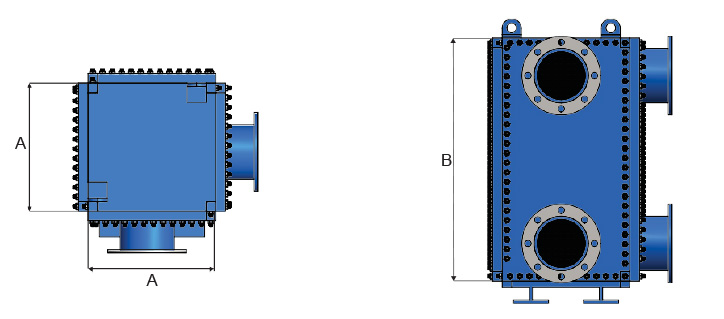Compabloc welded heat exchanger
Compabloc Heat Exchanger
The Compabloc is a fully welded compact heat exchanger designed for the complete range of process and utility duties. The Compabloc range provides the most efficient, cost-effective, compact and cleanable heat exchanger solution available today.
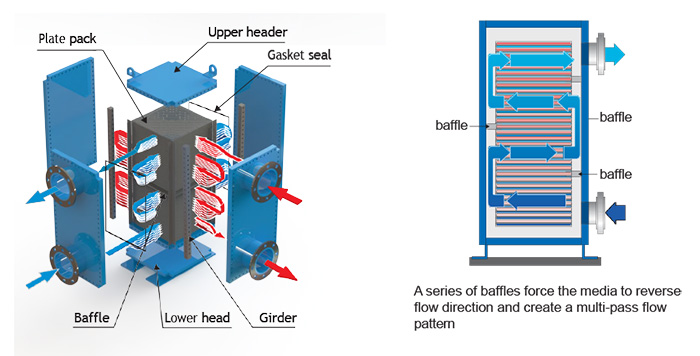
Design
The Compabloc range of welded heat exchangers with a focus on perfor- mance, compactness, and serviceability.
The heart of the Compabloc is a stack of corrugated heat transfer plates in 316L stainless steel, or other material. The plates are laser welded and form a compact core. This core is then enclosed and supported by four corner girders, top and bottom heads and four side panels (see Sectional view of Compabloc). These components are bolted together and can be quickly taken apart for inspection, service and cleaning.
The design can be configured in single or multi-pass arrangements in either co-current or counter-current operation, for liquid-to-liquid or two-phase duties.
Operating Principles
The two media in the Compabloc heat exchanger flow in alternately welded channels between the corrugated plates.
These corrugated plates promote high turbulence which provides high heat transfer efficiency and help minimize fouling. The media flows in a cross-flow arrangement within each pass (see figure below) while the overall flow arrangement is counter-current for a multi-pass unit (if required the unit can also be designed with overall co-current operation). Each pass is separated from the adjacent passes by a pressed baffle which forces the fluid to turn between the plate pack and the panel.
Compabloc’s flexible pass arrangements make it suitable for liquid-to-liquid duties with dissimilar flow rates, or two phase condensation or reboiler applications.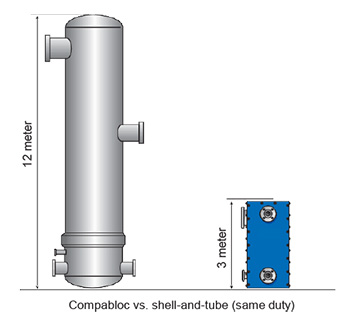
Applications
Oil & gas production
• Heat recovery in TEG systems (gas dehydration)
• Heat recovery, cooling, condensation & reboiling in amine systems (gas sweetening, sour service)
• Heat recovery, heating and cooling in crude oil dehydration and desalination systems
• Condensation in vapour recovery units
• Heat recovery, cooling, condensation and reboiling in NGL fractionation systems
Refineries
Various condensing & reboiling duties such as:
• Condensation in atmospheric and vacuum distillation
• Top condensing on fractionators in FCC, hydrocracking, H2S strippers, etc.
• Propane & butane overheads condensing in NGL and alkylation plants
• Reboiling in H2S strippers, sour water strippers and other columns
• Steam generation
Heat recovery, cooling & heating duties such as:
• Cooling of gasoline, kerosene, gas oil, diesel, pump-around etc
• Cooling & heating of bitumen, VGO (vacuum gas oil) and other heavy products
• Fractionator feed/bottom heat recovery
• Pre-heating of crude oil
• Desalted water/feed water heat recovery
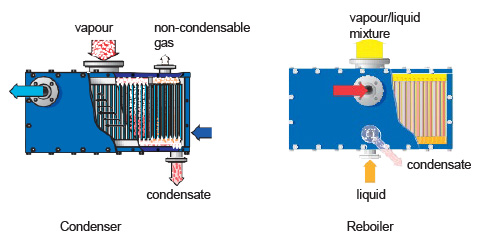
Hydrocarbon process industry
Condensation, heating/cooling, heat recovery and reboiling duties in the production of:
• primaries such as olefins, aromatics, aldehydes, acids, ethers, esters,ketones, and halogens
• intermediates such as acrolein, acrylic acid and acrylates, acrylonitrile, adipic acid, alkylbenzenes, aniline/nitrobenzene, benzenesulphonic acid, bispenol A, caprolactam, diisocyanates (MDI & TDI), ethylben zene/sty- rene, ethylene oxide/glycol,
hexamethylenediamine (HMDA), maleic anhydride, melamine, phenol,- phosgene, phthalic anhydride, propylene oxide/glycol, terephthalic acid (PTA)/dimethyl terephthalate (DMT), vinyl acetate, vinyl chloride, EDC
• polymers including polyethylene, polypropylene, polystyrene and styrene co-polymers, formaldehyde resins, polycarbonates, polyols, polyvinyl acetate, and polyvinyl alcohol
• other organic chemicals such as soaps and detergents, paintings and coatings
Pharmaceutical industry & specialty chemicals
• Special 2-pass condenser with built-in gas/liquid separation chamber and mist eliminator for reactor overhead and vent condensation
• Primary and vent condensation with hygienic design
• Solvent recovery
• Special 2-pass condenser with 2 cooling medias.
Coke oven plants
• Ammonia liquor scrubber cooling
• Debenzolized oil cooling
Chlorine alkali plants
• Chlorine gas cooling (drying)
• Hydrogen gas cooling (drying)
Fertilizer production
• Nitrogen gas cooling
• CO2 gas cooling (3-step compressor interstage cooler - gas drying)
• Ammonia heat recovery and stripping column reboiler
• Nitric acid cooling
Hydrogene peroxide plants
• Heat recovery and cooling of process streams
Ammonium nitrate
• Spent sulphuric acid heat recovery.
• Oleum cooling
Mining industry
• Nickel refining solvent extraction
Vegetable oil & fatty acids
• Feed/bottom in deodorization
HVAC, district heating, energy,utilities, general services
• Hot water production system
• Steam heating
• Heat recovery
Process Optimization
Because of the Compabloc’s unique design concept the possibilities for process optimization and flexibility are limitless. The Compabloc can be designed with both single-pass or multi-pass configurations. For condensation, reboiling and
liquid-to-liquid duties without temperature cross, the single-pass configuration is suitable with its total cross-flow. The large cross flow area and short flow path fit low-pressure condensing duties and allow very low pressure drops. A multi-pass configuration is suitable for duties with temperature cross and close temperature approaches.
The design concept allows a different number of passes on the two circuits thereby enabling large differences in flow rates between the hot side and the cold side. The baffling can easily be re-arranged to suit a new duty should the flow rates or temperatures change. Close temperature approaches down to 3ºC (5.4ºF) can be achieved.
The Compabloc can be mounted vertically, for normal liquid-to-liquid duties, condensation with sub-cooling and gas cooling duties, or horizontaly, for most condensation duties, reboiling or liquid-to-liquid duties where height is restricted.
Benifits of Compabloc Heat exchanger
• High thermal efficiency saves energy, boosts performance and reduces CO2 emissions
• Improved heat recovery with lower costs means very short payback time
• Compact design reduces installation costs and resolves bottlenecks for increased production
• Compabloc is fully mechanically cleanable, making maintenance simpler, quicker and more cost-effective
• Durable, laser-welded construction minimizes fouling and eliminates corrosion issues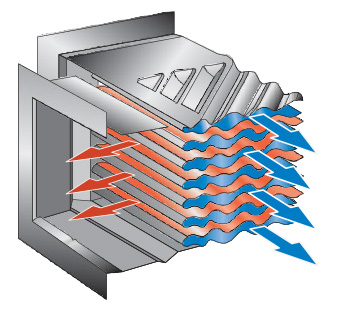
Two media flow in cross-flow in alternately welded channels.
|
Design temperature |
400°C down to -100°C |
|
Deisgn pressure |
From full vacuum to 42 barg |
|
Maximum area |
840 m² |
|
Maximum flow rate |
6,000 m³/h |
|
Lowest achievable temp difference |
3°C |
|
Duties |
cooling, heating, condensatio reboling, evaporation |
|
Performance |
Low to high thermal length |
